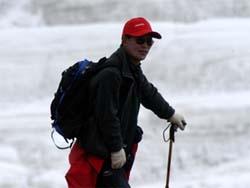
Prof. Yao Tandong.
To many people, bacteria and climate change are like chalk and cheese: the smallest creature versus one of the biggest phenomena on earth. Not really. Scientists with the Institute of Tibetan Plateau Research (ITP), Chinese Academy of Sciences and coworkers recently reported that small bugs deposited in ice and snow might tell how our climate has been changing.
The discovery might bring about a new indicator for climate change, which is by nature different from all previous physical or chemical benchmarks.
According to Prof. YAO Tandong, chief scientist of the research, bacterial abundances in ice cores vary in response to climatic conditions. With ice and snow samples taken from the Guoqu glacier on Mount Geladaindong, Yao and collaborators from ITP and Xiamen University measured the annual abundances of bacteria trapped in ice over the past seven decades. Analysis showed that bacterial levels rose with higher temperatures and dust concentrations.
The experts found that the bacterial abundance, lowest in 1938 and highest in 1997, increased in accordance with levels of oxygen-18, a natural, stable isotope of oxygen known to be well correlated with temperature. Usually, oxygen-18 concentration in ice will go up in warmer years.
The bacteria also increased with levels of dust in the core, scientists discovered when measuring calcium levels in visible dirty layers. The dust was likely transported onto the glacier during the spring dust storm season and trapped in ice through subsequent melting of the snow and ice.
Further analysis showed that seasonal factor plays a part in bacterial diversity. During the annual monsoon season, the microbes originated from very diverse environments including animal and human sources, while in non-monsoon seasons they mainly came from closer and cold environments.
The study is the first of its kind to connect bacteria with climate change for ecological studies. For a long time, world scientists kept their eye on how bacteria survive in thousand-year-old cold and dark ice cores in polar regions.
Since 2002, Prof. Yao and his colleagues have turned to exploring the microbial community in Malan and Puruogangri Ice Cores on central Tibetan Plateau. The present study on Geladaindong Ice Core is also the first high-resolution restoration of annual abundances of trapped bacteria.
Researchers will have to do more to quantify the above correlations, notes Yao, also director-general of ITP and a CAS Member.
Related News
Photos
More>>trade
market
- Sino-German team finishes field investigation into Tibetan lakes
- Successful automatic flight of a rotorcraft flying robot
- Deficiency of a -arrestin-2 Signal Complex Causes Insulin Resistance
- CAS Academician Chen Zhu Nominated ''People to Watch in 2009''
- China's Second National Assessment Report on Climate Change Being Drafted





